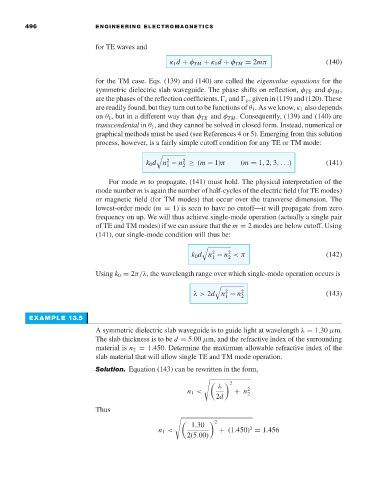Page 514 - Engineering Electromagnetics, 8th Edition
P. 514
496 ENGINEERING ELECTROMAGNETICS
for TE waves and
κ 1 d + φ TM + κ 1 d + φ TM = 2mπ (140)
for the TM case. Eqs. (139) and (140) are called the eigenvalue equations for the
symmetric dielectric slab waveguide. The phase shifts on reflection, φ TE and φ TM ,
are the phases of the reflection coefficients, s and p ,given in (119) and (120). These
are readily found, but they turn out to be functions of θ 1 .Asweknow, κ 1 also depends
on θ 1 ,but in a different way than φ TE and φ TM . Consequently, (139) and (140) are
transcendental in θ 1 , and they cannot be solved in closed form. Instead, numerical or
graphical methods must be used (see References 4 or 5). Emerging from this solution
process, however, is a fairly simple cutoff condition for any TE or TM mode:
2
2
k 0 d n − n ≥ (m − 1)π (m = 1, 2, 3,...) (141)
2
1
For mode m to propagate, (141) must hold. The physical interpretation of the
mode number m is again the number of half-cycles of the electric field (for TE modes)
or magnetic field (for TM modes) that occur over the transverse dimension. The
lowest-order mode (m = 1) is seen to have no cutoff—it will propagate from zero
frequency on up. We will thus achieve single-mode operation (actually a single pair
of TE and TM modes) if we can assure that the m = 2 modes are below cutoff. Using
(141), our single-mode condition will thus be:
2
2
k 0 d n − n <π (142)
2
1
Using k 0 = 2π/λ, the wavelength range over which single-mode operation occurs is
2
λ> 2d n − n 2 2 (143)
1
EXAMPLE 13.5
A symmetric dielectric slab waveguide is to guide light at wavelength λ = 1.30 µm.
The slab thickness is to be d = 5.00 µm, and the refractive index of the surrounding
material is n 2 = 1.450. Determine the maximum allowable refractive index of the
slab material that will allow single TE and TM mode operation.
Solution. Equation (143) can be rewritten in the form,
2
λ 2
n 1 < + n
2d 2
Thus
1.30
2
2
n 1 < + (1.450) = 1.456
2(5.00)

